News
Top 10 best-selling cars in India from the last decade
The list of the top 10 best-selling cars includes 7 cars from the Maruti Suzuki stable.
When it comes to best-selling cars in India, the brand that often tops the charts is Maruti Suzuki. If you look at the data from the last decade, it's a similar story.
Maruti Suzuki leads the pack from Hyundai and Mahindra. The list of the top 10 best-selling cars includes 7 cars from the Maruti Suzuki stable, with Alto being the best-selling model occupying a market share of 19.66%.
The Dzire was the second best-selling car of the last decade, followed by the Swift and WagonR. The market share of the Dzire and Swift was 14.93% and 14.31% respectively, while that of the WagonR was 12.22%.
The best-selling Hyundai of the last decade was the Elite i20 with a market share of 8.04%, followed by the Grand i10 (6.93%).
The only Mahindra that made it into the top 10 list was the Bolero with a market share of 6.77%.
The Maruti Baleno, Eeco and Omni complete the top 10 with a market share of 6.66%, 5.42% and 5.07%, respectively.
Source: Autopunditz
- Tags:
- Indian
- Sales
- Yearly sales
- Alto
News
Scoop! Next-gen Maruti Alto (Y0M) launch pushed to mid-2022
The current Covid-19 situation in the country may have forced Maruti to reschedule the launch.
It’s no longer a secret that Maruti Suzuki is working on the next-generation Maruti Alto (codenamed: Y0M). We have seen multiple test mules of the car, which suggests that the car’s development is in its advanced stages.
In fact, the new Alto was supposed to be launched in 2021. However, we have been told that it has now been pushed to mid-2022. While we don’t know the exact reason for the delay, the current Covid-19 situation in the country may have forced Maruti to reschedule the launch.
Spy images suggest that the new Alto is likely to retain its overall shape with short overhangs at the front and rear. It is expected to get a redesigned front fascia and new tail lamp clusters with the rear hatch release positioned in the centre.
At present, the Alto is offered with a 796cc, 3-cylinder petrol engine that makes 47 BHP and 69 Nm. The engine is mated to a 5-speed manual transmission. It also comes with a factory-fitted CNG kit. Technical details of the Y0M are still unknown.
Thanks to the Team-BHP fan (he prefers to remain anonymous) who sent this information in. Heartfelt gratitude for sharing it with other enthusiasts via this Team-BHP share page!
News
Maruti Alto: Useful Modifications & Maintenance
A few of these mods weren't part of my "top model" back then and the rest are maintenance works that were not readily found on the internet.
BHPian PratyushJaya recently shared this with other enthusiasts.
This thread is dedicated to some practical mods and part replacements that were be done on Maruti Suzuki Alto Type-2. A few of these mods weren't part of my "top model" back then and the rest are maintenance works that were not readily found on the internet. I would like to share these with fellow Alto owners. I don't have photos for everything so I will try to explain in depth where required.
This thread will only cover the procedure and parts required and most of these can be done at home with a toolkit. I enjoy doing work on my machines and some money was saved in the process. A few of these were carried out in a Friendly Neighbourhood Garage because I didn't have the required tools or experience.
Why I had to do some of these works will be talked about in another thread.
Each work is split into different posts and I listed them on the first post. Click on the desired item to jump to the particular post.
Modifications
- Install Latch Release for Boot/Tailgate/Dicky
- Install Adjustable ORVM (Outside Rear View Mirror)
- Install cabin filter
Maintenance
- Replace Air Conditioner Control Unit backlight bulbs
- Replace A/C button
- Service A/C blower unit
- Replace Speedometer backlight bulbs
- Replace battery tray and repair corrosion
- Change wiper arms
- Replace PCV Hose
- Replace Breather Hose
- Replace Exhaust Resonator
- Replace Steering Rack
- Clean Coolant Reservoir Tank
Most of the parts used are from the OEM or aftermarket parts of equal or better specifications.
Some of the parts weren't properly catalogued in the Service Booklet and not much information was available online so I thought my posts might help someone save time and effort.
If you see an item without a hyperlink to the post, it is because I am compiling the photos and the written material.
These works were done on Alto Type-2 but may also be done on Alto Type-1 and even Alto K10 Type-1 with slight part changes if any.
Modification
1. Install Latch Release for Boot/Tailgate/Dicky
Parts Needed:
- 83310M76G50 - Lever Compfuel Lid Opener (₹51) X1
- 82650M79G00 - Striker Back Door (₹38) X1
- 83350M79G20 - Cable Comp Back Door Opener (₹116) X1
- 75411M76G20 - Clamp for Cable (₹2) [Optional] X3

Total cost of parts: ₹205-₹211
Prices as of March, 2021
Tools Needed
- Phillips Screw Driver (Socket and Ratchet would be better)
- Hex Head Socket Set and Ratchet
- Combination Pliers
- Penetrating fluid (WD-40 might also work)
Time Required: 3 Hours
Procedure
- Spray penetrating fluid on the four bolts of the driver seat. Good time to check which socket will you need to remove them.
- Remove the clips for the driver side dash trim. Then remove the trim. To remove the clip push on the button at the centre till it depresses a bit and clicks into place. Do not push it further. Then pull out the clip body entirely along with the button. You may use a flat-head screwdriver to push on the button and then for prying out the clip body.
- Remove driver side door sill trim. Carefully pull it out by placing fingers towards the inside of the trim and pulling it upwards.

- Remove the rear seat cushion by pressing on the tabs at both ends of the seat and pulling the cushion upwards while holding the tab pressed. Pull the seat out of the car.
- Remove your parcel tray. Unscrew the parcel tray support on the driver side of the vehicle and remove the trim.
- Remove the clips holding the tail end trim. Then remove the trim.

- Remove the clips holding the carpet in place on the driver side of the car. They are located along the pillar near the taillamp and along the cabin side of wheel well.
- Once all the clips are removed, pull out carpet gently. They are held in place by Velcro strips on the pillars.
- Remove the 4 bolts holding the driver seat to the chassis. Penetrating fluid would have done the job by now. They are often quite tight. Use longer ratchet if needed. Remove the seat and place it outside the car.
- Now remove the clips on the door sill trim on the back door of the car. Slide out the trim.

- Lift the floor carpeting on the driver side carefully. Over the years the carpet gets stuck to the compacted sound deadening material and if you pull out too fast the layers will separate. I was unable to remove my driver seat as it was interfering with gear lock installed by the dealership. If you face such an issue, do remove the chair and lift as much carpet as you can under the driver seat and on the rear seat footwell.
- Remove the Fuel Lid opened Lever attached to the frame. You will need a Phillips head screw driver. Do not remove the fuel lid cable yet.
- Remove the old latch striker screwed on to the tail end member. They are pretty tight and I had to use my ratchet with Philips head attachment to break free the 2 screws. I didn’t want to strip the screw heads. You may use a Phillips head screw driver.
- The cable has different ends. The ball end of the cable attaches to the striker. Take the new cable and push it through the hole on the tail end member till it emerges on the spare tyre wheel well. Pull it out till you are left with a foot of cable hanging out of the tail end member.
- Attach the cable to the striker. I don’t have images for it. It was pretty straight forward.
- Now screw the striker to the tail end member. When standing at the rear end of the car, the cable will come out to the driver side. You will notice a small lever on your boot latch. The striker hits the lever to unlock the boot. So, install it accordingly. Do not tighten the screw yet. Just screw them enough to keep it in place.

- Now route the cable alongside the wires running along the driver side of the rear wheel well. You might notice that the clamp for boot door cable has already been installed from factory. It was pre-installed on mine. If you don’t want to take a chance, you can buy the clamp for cable. 3 pieces are required as per parts manual. I would suggest you buy at least 5. Pop the cable into those clamps. For those who didn’t have the clamps, you will know where to install them when route the cable.
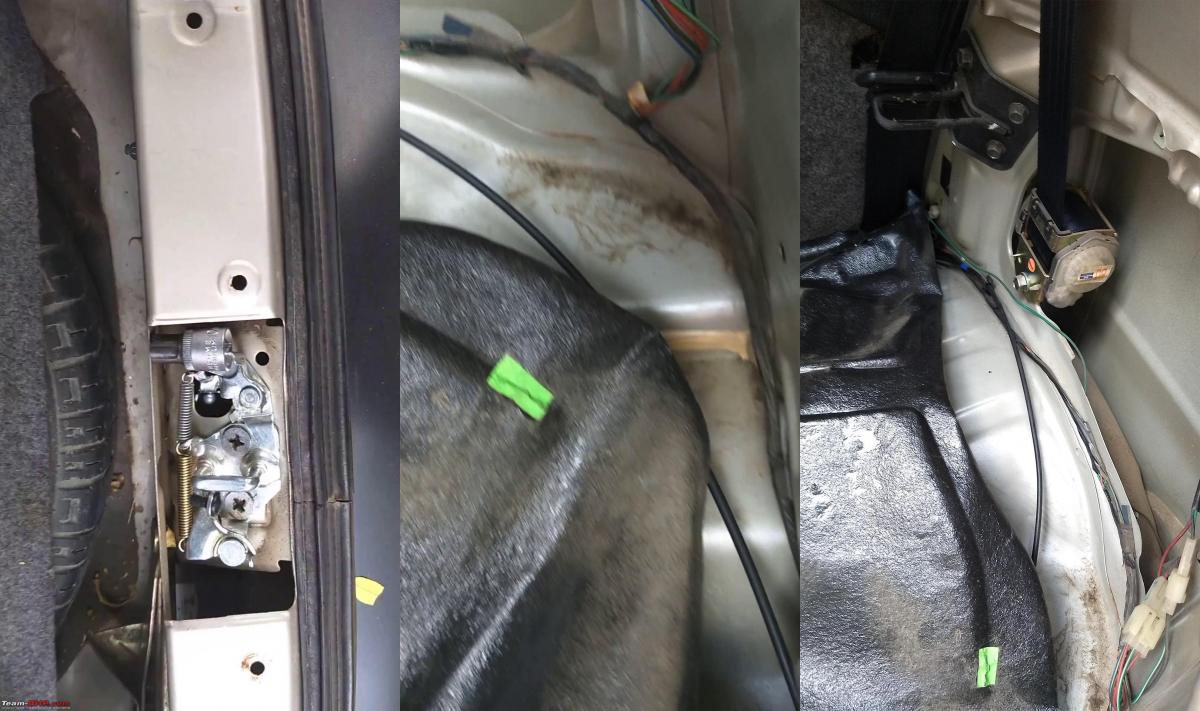
- Next, the cable travels along the rear seats and then takes a turn to the passenger side after the seats. There’s ridge running along the middle. The cable needs to be routed along this till it hits the cross member below the driver seat.
- Thread the cable through this cross member. Have a look the fuel lid cable going towards the lever. Do it accordingly. I was unable to remove the seats so I figured it out by running my hands over the floor pan.
- Observe how the fuel lid cable is connected to the old Lever. Remove it and connect the new Lever to the fuel lid cable and then the boot cable. The cylindrical end of the cable is attached to the levers. Make sure that the cables are not intertwined.
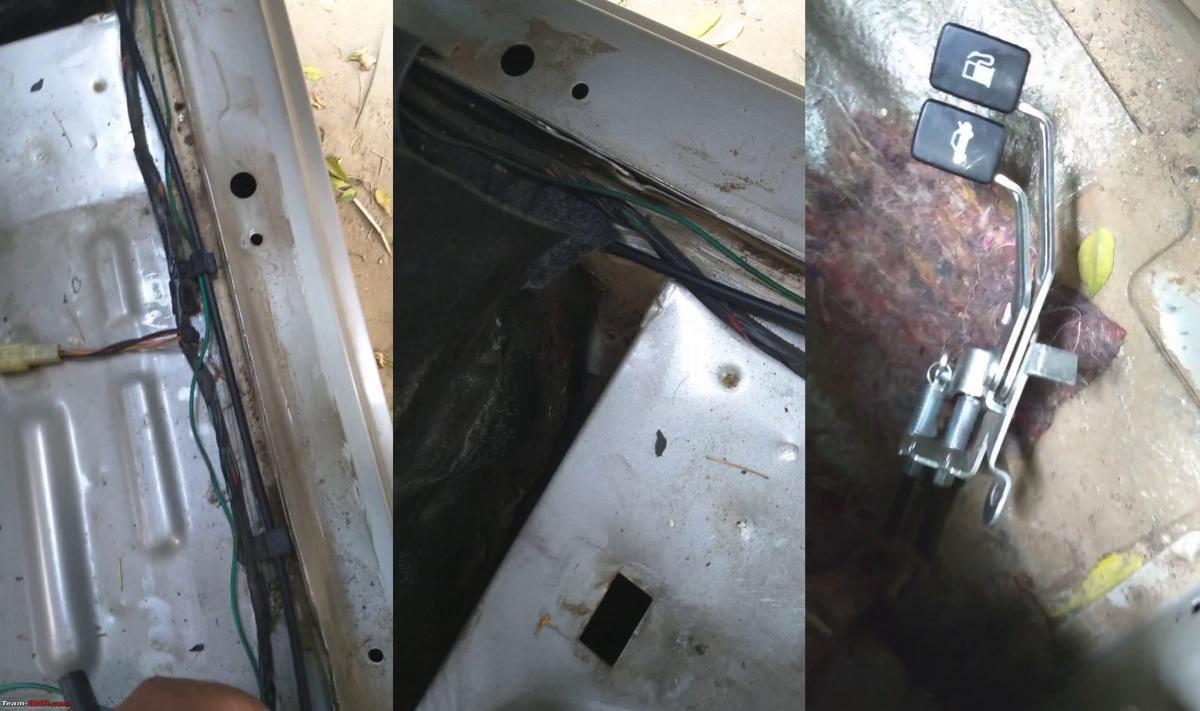
- Attach the new Lever to the frame by its single screw. There’s also a tab that keeps it in place. Make sure it is positioned properly. Now test the operation of the fuel lid door and boot opener by pulling on the levers and verifying if the striker is moving and the fuel lid opener pin is being pulled.
- Tighten the 2 screws on the striker completely. Make sure the cable is routed properly and pushed into the clamps.
- Close the boot and fuel lid and test the levers. I had to bend the striker a bit with combination pliers to make it move the lever sticking out of the latch.
- Attach the carpets back into place staring with boot and moving forward to the driver side. Make sure the carpet is laid flat and in its original position.
- Now push on the buttons on the clips from the other side so it sticks out a bit from the clips. Clip the carpet in place inside the boot. Push on the buttons sticking out to lock the clip in place.
- Attach driver side door sill trim piece. Make sure to slide it under the pillar trim.
- Attach the driver side dash trim. Push the clips in and lock it in place. Make sure this trim goes over the door sill trim.
- Attach the rear door sill trim and install the clips holding it in place.
- Attach the parcel tray holder trim piece.
- Attach the tail end member trim piece and install all the clips holding it in place.
- Inspect the carpet for any kinks or irregularities. Install the driver seat and bolt down the 4 bolts securely.
- Install the rear seat with back end into the frame first. Then push the rectangular hooks into the frame till the seat is affixed firmly.
- Installation complete! Clean your car, keep your sockets back in your toolkit.
Check out BHPian comments for more insights and information.
- Tags:
- Indian
- Alto
- Modifications
- DIY
News
The curious case of the Maruti Alto and its pricing
Maruti launched Alto way back in 2000 in the price range of 2.7 to 2.9 lakh rupees. And now, 21 years later, Alto range still starts from 2.99 lakh rupees.
BHPian Emvi recently shared this with other enthusiasts.
Few days ago, I stumbled across a thread which had a discussion about the pricing of cars when first launched, how steadily the prices have increased, and for how much the same cars are being retailed now. And it is quite obvious that Toyota Innova is the one name that pops up in the mind of most people and not without reasons. When launched in 2005, the ex-showroom prices of Innova across variants ranged from 6.8 to 10 lakh rupees. At present, the ex-showroom prices range from 16.1 to 25.5 lakh rupees! This equates to a price increase of approximately 2.5 times in about 16 years. Taking into consideration the relatively higher present-day road taxes and the insurance premiums, on-road prices probably have gone up almost 3 fold since the initial launch. Probably the same holds true for the Toyota Fortuner as well.
It's not just the Toyotas that have become pricier exponentially. In fact, most cars and even two-wheelers have in the same period. The fact that Innova still has no real competition and the fact that the price range actually covers couple of segments of vehicles probably highlights Innova more than the other cars. It may also be true that the percentage increase in the price of Innova might be the highest among all the cars. As clichéd it might sound, there are exceptions. In fact, there is one. It is none other than Maruti Alto.
Maruti launched Alto way back in 2000 in the price range of 2.7 to 2.9 lakh rupees. And now, 21 years later, Alto range still starts from 2.99 lakh rupees. Astonishing! Let's not forget, today even the base model is equipped with driver side airbag, ABS and reverse parking sensors. And yes, for once, let's not get into the discussion/argument regarding how safe/unsafe the car is. Over the period, Alto has undergone minor and major facelifts, changes to the platforms/body panels, feature additions and a lot more. One thing that hasn't changed much is the pricing! In fact, when Maruti launched the completely revamped model in 2012, if I am not wrong, it was priced cheaper than the outgoing version! While people have divided opinions about Maruti cars, I assume that not many can deny the fact that Maruti cars are generally niggle free, reliable, economical and easy to maintain. A perfect recipe for an entry-level car, IMO.
Twenty years is a long period and a lot of things have changed for sure. If I can summarise in one word, the production cost/input cost would have definitely gone up multifold. In spite of all this, an Alto still costs the same (well, almost) as it was 20 years back!
Here's what BHPian museycal had to say on the matter:
While Innova has gone upwards in looks, feel, materials, features etc. with every iteration, the Alto has moved downwards. Maybe the owners can chime in here, but from the limited experience I have with the Alto of mid-2000s, they look and feel solid even today. I am not sure about the latest-gen models though.
That's not to take anything away from the value proposition of an Alto though. An Alto was affordable, good looking, fun-to-drive, economical car back then, and it happens to be the same today too.
PS: I believe that just the sheer volumes that the Alto, Swift and Dzire bring for Maruti, MSIL may be able to apportion the inevitable price rise much gently for these models, of course backed by the advances in manufacturing technologies.
Here's what BHPian haisaikat had to say on the matter:
Essentially, Alto 2000 vs Alto 800 in 2021 is the same car whose platform is unchanged. When you keep the platform unchanged for 21 years, you have reached your breakeven of R&D cost way earlier and now it is just replication and profit munching. Yes, cost of materials have increased but so has the volumes of sale numbers in MSIL favour. Adding two airbags in the same platform does not help boost your NCAP that much and hence does not make it safer overnight. There was a reason why Alto K10 costed much more.
Where one should look at is how the service cost is as compared to 21 years back including parts duraility. It may be like buying those yesteryear colour inkjet printers where a subsequent cartridge used to cost as much as the whole printer + stock cartridge equivalent.
There are already several news elsewhere that MSIL may discontinue the Alto and come up with a newer platform car and when platform upgrades, definitely cost appreciates.
Since comparison is with Innova, the platform may not have changed but the power, transmission, internal trims have significantly gone up. When you upgrade power by more than 60-70% you have to upgrade your transmission, brakes, everything to cope up with that.
Check out BHPian comments for more insights and information.
News
Maruti launches Festive Editions of Alto, Celerio & WagonR
The Festive Editions come equipped with additional accessories.
Maruti Suzuki has launched Festive Editions of the Alto, Celerio and WagonR this Diwali. The cars come equipped with accessory kits that are available at Rs. 25,490 for the Alto, Rs. 25,990 for Celerio and Rs. 29,990 for the WagonR.
The Alto Festive Edition comes with a Pioneer touchscreen audio system, 6-inch Kenwood speakers, security system, dual-tone seat covers and steering wheel cover.
The Celerio Festive Edition gets a Sony 2-DIN audio system with Bluetooth, seat covers, piano black body side mouldings and designer mats.
The WagonR Festive edition is equipped with front and rear bumper protectors, front upper grille chrome garnish, side skirts, seat covers and an interior styling kit.
The accessories will be fitted at the dealer end.
News
Maruti Suzuki Alto 40 lakh sales up!
Maruti has sold over 40 lakh units of the Alto in 2 decades.
Maruti Suzuki is celebrating a new sales milestone. The carmaker claims to have sold over 40 lakh units of the Alto.
This year, Maruti is also celebrating 20 years since the launch of the Alto in India. The model was introduced in 2000 and four years later, it became India's best selling car. It has emerged as the largest selling model in the passenger car segment every year since the past 16 years.
By 2008, Maruti had sold 10 lakh units of the Alto. In 2012, Maruti introduced the Alto 800. During the same year, sales crossed the 20 lakh mark. By 2016, 30 lakh units were sold.
According to Maruti, 59% of Alto sales came from upcountry markets. This has now increased to 62% for the current year. The car has been exported to over 40 countries including markets in Latin America, Africa and South Asia.
News
Next-gen Maruti Alto Spied
The overall shape of the next generation Alto looks familiar.
A test mule of the next generation Alto has been caught testing for the first time.
The spy images suggest that the new Alto could retain its overall shape. In side profile, the car looks identical to the current model. The car appears to have new headlights and tail lamp clusters, while the side turn indicators are mounted on the front fenders.
The door handle for the rear hatch can be clearly seen in one of the images. The car also gets a redesigned rear bumper that has reflector strips on either end. The test car has a roof spoiler and is riding on steel wheels.
The Maruti Alto has been the no. 1 selling car in India for 16 consecutive years. Just last month, the carmaker achieved a milestone as sales crossed the 40-lakh-unit mark.
Currently, the Alto is powered by a BS6-compliant 796cc, 3-cylinder petrol engine that produces 47 BHP @ 6,000 rpm and 69 Nm @ 3,500 rpm. The engine is mated to a 5-speed manual transmission. The car is also available with a factory-fitted CNG kit. On CNG, the engine output drops to 40 BHP and 60 Nm.
News
Japan: Next-gen Suzuki Alto, WagonR, Vitara launch dates out
According to a Japanese media report, Suzuki could introduce the next generation Alto, WagonR and Vitara by December 2021.
The first model that is believed to be lined up for launch is the new Alto. The ninth-generation of the hatchback is reportedly scheduled to be unveiled in December 2020. It could retain its lightweight platform and might be offered with a new R06D type engine. This is a 658cc unit that develops 48 BHP.
A sportier version of the Alto, dubbed the Alto Works, is also said to be in the offing and is scheduled to debut in October 2021. The car could be powered by a turbocharged R06D type engine with a different bore and longer stroke. Such a design is said to improve mid-range torque and fuel efficiency.
The report also states that Suzuki could introduce the new WagonR in December 2021. The current model has been around since February 2017. In December 2019, it received the R06D type engine.
Coming to SUVs, the new Suzuki Vitara (also known as the Escudo) is being readied for a January 2021 launch. It will be based on the same monocoque chassis and will be manufactured in Hungary.
The SUV will be powered by a 1.4-litre, turbocharged engine with a 48V mild-hybrid system. It will also get a 1.0-litre, turbocharged 3-cylinder engine option.
Finally, there are reports of a 5-door version of the Jimny that could go on sale in India in December. Suzuki is unlikely to offer it in the Japanese market.
News
Maruti Alto 40 lakh sales up!
Maruti Suzuki is celebrating a new sales milestone as Alto sales cross the 40 lakh unit mark.
The Alto was launched in the year 2000. By 2008, Maruti Suzuki had sold 10 lakh units of the small hatchback. The next 10 lakh units were sold in just 4 years. In 2016, Alto sales crossed the 30 lakh unit mark.
The Maruti Alto has been the no. 1 selling car in India for 16 consecutive years. According to the carmaker, 76% of Alto customers were first time car buyers.
The Alto is powered by a BS6-compliant 796cc, 3-cylinder petrol engine that produces 47 BHP @ 6,000 rpm and 69 Nm of torque @ 3,500 rpm. The engine is mated to a 5-speed manual transmission. The car is also available with a factory-fitted CNG kit. On CNG, the engine output drops to 40 BHP and 60 Nm.
News
Maruti developing two sub-Rs. 5 lakh cars
According to a media report, Maruti Suzuki is developing two sub-Rs. 5 lakh cars for the Indian market.
The report suggests that Maruti is working on an new model codenamed Y0M. It is expected to be powered by an 800cc engine and could replace the Alto. The entry-level model could be launched during the 2021 festive season.
The second car is believed to be codenamed YNC. It is expected to be powered by a 1.0-litre engine. The YNC could replace the Celerio in the Indian market. It is rumoured to be launched by the end of 2020.
Pages




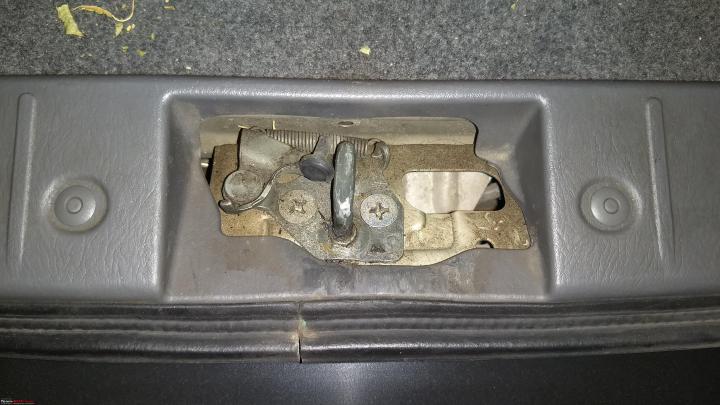








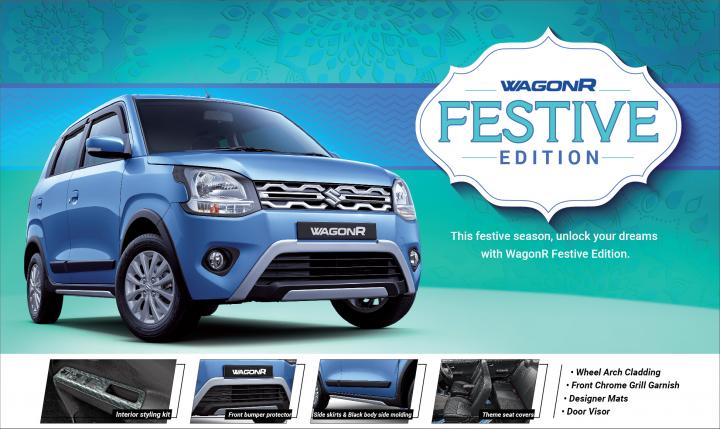

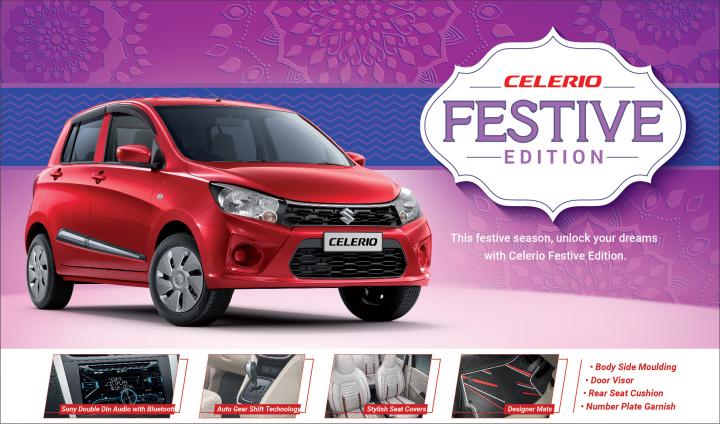








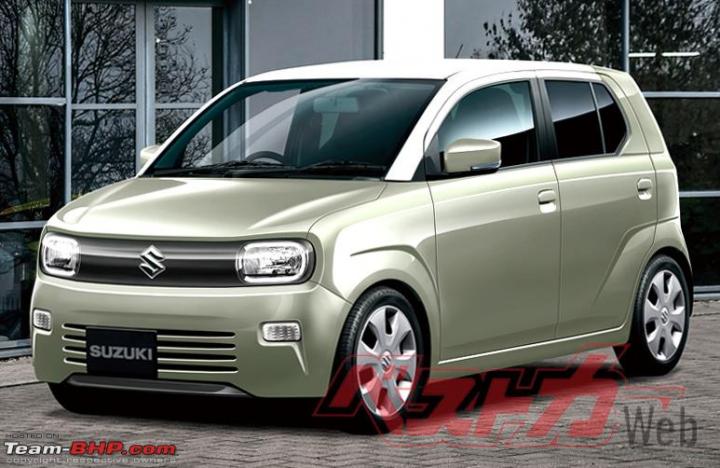
.jpg)



.jpg)




